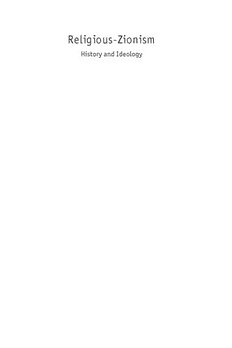Table Of ContentReligious-Zionism
History and Ideology
Emunot: Jewish Philosophy and Kabbalah
Dov Schwartz (Bar-Ilan University, Ramat-Gan), Series Editor
Editorial board
Ada Rapoport-Albert (University College, London)
Gad Freudenthal (C.N.R.S, Paris)
Gideon Freudenthal (Tel Aviv University)
Moshe Idel (Hebrew University, Jerusalem)
Raphael Jospe (Bar-Ilan University)
Ephraim Kanarfogel (Yeshiva University)
Menachem Kellner (Haifa University)
Daniel Lasker (Ben-Gurion University, Beer Sheva)
Religious-Zionism
History and Ideology
Dov Schwartz
Translated by Batya Stein
Boston
2009
Library of Congress Cataloging-in-Publication Data
Schwartz, Dov.
Religious-Zionism : history and ideology / Dov Schwartz ; translated by Batya Stein.
p. cm. — (Emunot: Jewish philosophy and Kabbalah)
ISBN 978-1-934843-25-3
1. Religious-Zionism. 2. Religious-Zionism—History. I. Title.
DS150.R32S3694 2009
320.54095694—dc22
2008050465
Copyright © 2009 Academic Studies Press
All rights reserved
ISBN 978-1-934843-25-3
Book design by Yuri Alexandrov
Published by Academic Studies Press in 2009
28 Montfern Avenue
Brighton, MA 02135, USA
[email protected]
www.academicstudiespress.com
iv
Contents
Preface . . . . . . . . . . . . . . . . . . . . . . . . . . . . . . . . . . . . . vii
Chapter One. A Revolutionary Consciousness . . . . . . . . . . . . . . . . . . 1
Chapter Two. Rabbi Reines and the Foundation of the Mizrachi . . . . . . . . . 10
Chapter Three. Religious-Zionist Education: Beginnings . . . . . . . . . . . . 19
Chapter Four. Rav Kook: An Orthodox-National Alternative to Religious-Zionism 27
Chapter Five. The Foundation of the Chief Rabbinate . . . . . . . . . . . . . . 34
Chapter Six. Ha-Po‘el ha-Mizrachi: Against the Exile and the Bourgeoisie . . . 42
Chapter Seven. Criticizing Zionist Policy . . . . . . . . . . . . . . . . . . . . . 51
Chapter Eight. The Settlement Drive . . . . . . . . . . . . . . . . . . . . . . . 63
Chapter Nine. Religious-Zionism and the Holocaust . . . . . . . . . . . . . . . 71
Chapter Ten. Israel’s First Years: Hopes and Disappointments . . . . . . . . . . 81
Chapter Eleven. From Rearguard to Vanguard: The Struggle for Greater Israel . . 95
Chapter Twelve. Religious-Zionism in the United States . . . . . . . . . . . . 105
Chapter Thirteen. Religious-Zionism: Present and Future . . . . . . . . . . . 115
Bibliography . . . . . . . . . . . . . . . . . . . . . . . . . . . . . . . . . 124
Index of Names . . . . . . . . . . . . . . . . . . . . . . . . . . . . . . . . 138
Index of Subjects . . . . . . . . . . . . . . . . . . . . . . . . . . . . . . . 143
v
Contents
vi
Preface
PREFACE
In this book, I review the history of religious-Zionism from a historical and
ideological-theological perspective. My basic assumption is that religious-
Zionism cannot be fully understood solely through a historical description, or
even from social, political, and philosophical vantage points.
A periodization assumption is warranted here: religious-Zionism was
established in 1902 with the creation of the Mizrachi, and traces its roots to
the Hibbat Zion movement. To some extent, religious-Zionist thought repre-
sents a continuation of the work of Mordechai Eliasberg, Shmuel Mohilewer,
and Naphtali Zvi Berlin (Ha-Natziv), central Hibbat Zion leaders in their spiri-
tual influence and in their action who understood, for instance, that the ideal
of national renaissance requires them to be open to general culture. Some
scholars have dated the beginning of religious-Zionism to the end of the
nineteenth century and even earlier. Religious-Zionist historiography has
indeed attempted to emphasize the movement’s continuity and, in this view,
Abraham was the first Zionist and Nahmanides’ emigration to Eretz Israel was
another landmark in the realization of the Zionist-religious ideal.
My approach, however, views the creation of the Mizrachi as the true
revolution. At this point, the religious and rabbinic world entered institu-
tionalized politics and, to some extent, assumed the demands of modernity.
At this point, religious Jews acknowledged that the promotion of their cause
depended upon their recognition of the secular political establishment (the
World Zionist Organization) and actual involvement in its activity. Through
this act, the followers of Yitzhak Ya‘akov Reines and Ze’ev Jawitz recognize
that the redemption of the people and of the land is led by a secular institution
that strives to establish a secular regime and a secular culture. Hibbat Zion
members did not take such a step and did not commit themselves to the iden-
tity crisis that accompanied it. Religious-Zionism, then, begins when the
Mizrachi becomes a faction of the World Zionist Organization.
vii
Preface
I am grateful to Brill for permission to include in this book an adapted
version of entries I wrote for the Encyclopaedia of Judaism, edited by Jacob
Neusner, Alan J. Avery-Peck, and William Scott Green. I would like to thank
Dr. Raphael Jospe for his comments and David Louvish for the translation of
a previous version of Chapter One.
This work was translated and edited by Batya Stein, who skilfully turned it
into a clear, fluid, and unified text, and I thank her for it.
Religious-Zionism
History and Ideology
Contents
x

